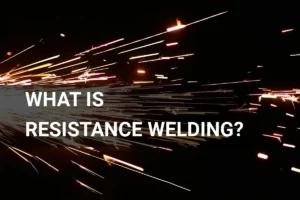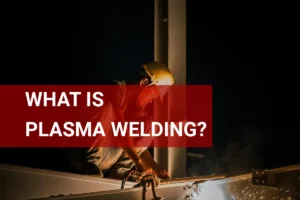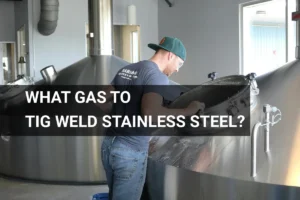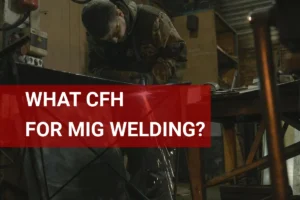What is FCAW Welding? Learn the Process, Applications, and More
Published on: December 1, 2024 | Last modified: March 4, 2025
By: Joe Carter
FCAW stands for Flux-Cored Arc Welding. It’s a popular welding process that uses a tubular wire filled with flux to make strong welds.
I was just discussing FCAW the other day with a buddy of mine. When we talk about what is fcaw welding, it’s crucial to follow the techniques closely. I’ve found, through personal experience, that small changes can make a huge difference in the quality of your welds. Paying attention to details is key!
In this article, we’ll cover several points like how FCAW welding works, types of FCAW welding, steps for setup, factors that affect your welds, typical issues you might face, aftercare and inspection tips, applications, and alternative methods similar to FCAW welding. Get ready to sharpen your skills!
Contents
- What is FCAW Welding?
- How Does FCAW Welding Work?
- Types Of FCAW Welding
- Steps to Set Up FCAW Welding
- Factors Affecting FCAW Welding
- Typical Issues With FCAW Welding
- Aftercare, Inspection, and Advanced Tips for FCAW Welding
- Typical Applications Of FCAW Welding
- Alternatives for Achieving Results Similar to FCAW Welding
- Key Differences Among Welding Techniques
- Frequently Asked Questions (FAQs)
- Conclusion
- References
What is FCAW Welding?
Flux-cored arc welding (FCAW) uses a tubular electrode filled with flux, creating a shielding gas while welding. It’s great for outdoor projects and thick materials. Typical applications include construction and shipbuilding due to its speed and efficiency.
How Does FCAW Welding Work?
What is Flux-Cored Arc Welding, or Flux-Cored Arc Welding, is a semi-automatic welding process that uses a tubular electrode filled with flux. This technique creates an electric arc between the electrode and the workpiece, melting both the electrode and the base metal. Typically, the process operates on direct current (DC) with a voltage range of 18 to 30 volts. It’s efficient for thicker materials, using wire diameters from 0.8 mm to 2.4 mm (0.030 In to 0.095 In) and achieving welding speeds of up to 12.7 kg/h (28 Lb/h).
FCAW excels outdoors because the flux generates a shielding gas during welding. This enhances weld quality and reduces contamination from wind. Compared to other methods, like MIG (Metal Inert Gas) or SMAW (Shielded Metal Arc Welding), it offers remarkable versatility and efficiency for various applications.
From my experience, FCAW welding excels in speed and durability. I’ve used it for construction projects in challenging weather, and the results were impressive. This method is popular for handling various materials, making it essential for heavy-duty applications.
Types Of FCAW Welding
What are the types of flux-cored arc welding?
-
Self-shielded FCAW Welding
This type doesn’t need external shielding gas, making it convenient. Self-shielded welding uses the flux in the electrode to create a shield around the weld. Start by feeding the flux-cored wire into the welder, igniting the arc, and welding on thick or dirty metals. When dealing with welding activities, it is essential to understand how to address welding burns on skin.
-
Gas-shielded FCAW Welding
This type uses shielding gas for better control over the weld. In gas-shielded FCAW, the flux-cored wire is combined with an external gas for protection. Set up your welder with the appropriate gas mixture, typically a mix of argon and carbon dioxide, and weld on clean metal for a high-quality finish. The choice of gas can greatly influence the welding outcome—learn more about what gas is used for welding.
-
Multi-pass FCAW Welding
This technique involves multiple layers for thicker materials. Multi-pass welding builds up the weld joint with several beads. Start with a root pass, then add more passes based on the joint thickness to ensure good penetration and strength.
-
Single-pass FCAW Welding
This method works for thinner materials, making it faster. Single-pass welding creates one continuous weld without layering. Focus on the correct settings for feed speed and voltage to achieve a good bead without extra layers.
-
Electrode FCAW Welding
This type uses electrodes specifically designed for FCAW. Electrode FCAW welding uses a continuous flux-filled wire to create the arc and protect the weld. Feed the wire through the roller, connect it to the power supply, and begin feeding into the weld zone, maintaining the proper angle for optimal results. When it comes to handling coated materials, it’s crucial to consider the dangers of welding galvanized steel for safety.
So far we covered the different types of FCAW welding. Next, let’s look at the steps for setting up FCAW welding.
Steps to Set Up FCAW Welding
Now, we’ll cover the steps of the flux-cored arc welding process to get you started right!
-
Adjust the Voltage and Wire Speed
First, determine the material thickness. For materials around 6 mm (0.24 In) thick, set the voltage to about 24-26 volts and the wire speed to 200-300 inches per minute (Ipm). This will ensure proper penetration and weld bead profile. Verify these starting settings with FCAW welding specifications for your equipment, as variations may be necessary for different wire types.
The right combination is critical. High voltage can cause burn-through, while low voltage leads to poor fusion. Test with scrap material before starting your main project. Trust me, tweaking this might save you a headache later.
-
Select the Correct Flux-cored Wire
Choose the appropriate flux-cored wire based on your joint and material. For example, E71T-1 wire suits carbon steel, while E81T1-Ni1 is great for weathering steel. This is essential for ensuring proper strength and quality in the weld. Verify the wire diameter; it typically ranges from 0.8 mm to 1.2 mm (0.030 In to 0.045 In).
Your choice of wire affects penetration and corrosion resistance. Using the correct flux will enhance your weld quality. You’ll see fewer defects and better performance in any environment.
-
Set Up Your Workpiece Position
Position your workpieces firmly on a stable surface. It’s crucial to hold them at the right angle, usually around 20-30 degrees, for better access to the electrode. Use clamps to secure the materials and avoid movement during welding, ensuring a consistent bead.
A good setup minimizes distortion. Wide gaps can lead to challenges, so maintain close fits. I once faced misalignment during a project, and it cost me extra time. Don’t skimp on this step!
-
Start the Welding Process
Now that everything’s ready, ignite the arc and maintain a steady travel speed. For FCAW, aim for about 8-12 inches per minute, depending on the joint type. Maintain the specified arc length; typically, keep it around 6 mm (1/4 Inch) for optimal results.
Watch the bead and adjust as needed. If you notice irregularities, pause and assess your settings or technique. It’s easier to fix problems mid-process than to grind out a whole weld later!
-
Finish and Clean the Weld Joint
After welding, turn off the machine and allow it to cool. Clean off any slag with a wire brush to keep the weld area free from contaminants. Aim to do this before any post-weld treatment or inspection.
Finally, check your welds visually for consistency and make necessary repairs. Trust me, addressing issues now will pay off in longevity and performance. You don’t want weak joints down the line!
So far we covered the process of setting up FCAW welding. Next, let’s look at the factors that influence FCAW welding.
Factors Affecting FCAW Welding
What factors influence the performance and outcome of FCAW welding?
-
Welding Speed
Welding speed affects bead appearance and penetration. Speeds of 10 to 30 inches per minute (25 to 76 Cm/min) optimize efficiency and quality.
-
Electrode Type
The electrode’s composition influences flux characteristics. A wire diameter of 0.030 to 0.045 inches (0.76 To 1.14 Mm) delivers better results for various materials.
-
Welding Position
The welding position affects heat distribution. Flat and horizontal positions are ideal; vertical positions require more skill, especially with different FCAW wire types.
-
Base Material Thickness
Material thickness directly affects heat settings. For metals thicker than ¼ inch (6.35 Mm), higher voltage and wire speed are crucial to prevent burn-through.
-
Environmental Conditions
Wind and temperature can impact shielding gas effectiveness. In windy conditions, using a windscreen is advisable since drafts can disperse protective gases, reducing weld quality.
You should now have a good understanding of the elements influencing FCAW welding processes. In the next part, we’ll discuss common challenges in FCAW welding.

Typical Issues With FCAW Welding
Let’s examine unique problems specific to FCAW welding.
-
Inconsistent Arc Stability
FCAW welding may have an unstable arc due to settings or wire feed speed. Diagnose the issue by checking the voltage, ensuring it’s between 22-28 volts. Adjust as needed to stabilize the arc.
-
Excessive Spatter
FCAW often generates more spatter than other methods. If your gas flow’s low or wire feed speed’s too high, reduce both to minimize spatter.
-
Poor Penetration
Poor penetration in FCAW can result from incorrect travel speed or insufficient heat. Test by performing a perpendicular weld and adjusting amperage to 150-250 amps as needed.
-
Inadequate Fusion
FCAW can cause inadequate fusion at the weld bead edges. Check for a smooth transition and ensure the joint preparation is clean and properly fitted.
-
Undercutting
Undercutting in FCAW occurs if the travel speed is too fast. To fix it, slow down and adjust the torch angle for smoother delivery.
We covered common challenges in FCAW welding. Next, we will cover aftercare, inspection, and advanced tips for FCAW welding.
Aftercare, Inspection, and Advanced Tips for FCAW Welding
Here’s crucial advice on aftercare, inspection, and advanced tips for effective FCAW welding.
Aftercare Tips
After welding with FCAW, clean the work area to avoid contamination. Use a wire brush and a handheld vacuum (Or a Blower) to remove slag—target particles smaller than 0.5 mm (0.02 Inches). Store your flux-cored wire at 20°C to 25°C (68°F to 77°F) to keep it dry and improve performance. For those working with a Lincoln 225 welder, explore how to properly wire this specific model to optimize your welding results efficiently.
Inspection
Inspect weld quality with a visual check for porosity (Tiny Holes) and undercuts. Use a magnifying glass if needed. I typically use a Dexterity Spectrometer, noting any flaws larger than 1 mm (0.04 Inches) for potential repairs before proceeding.
Expert Tips
Adjust wire feed speed (WFS) to 4.5 to 5.0 m/min (15 to 16 Ft/min) for thicker materials. Optimize voltage based on material thickness; keep it between 22V and 28V. For better penetration, use 1.2 mm (0.045 In) diameter wire with a slightly shorter arc length—about 6 mm (1/4 Inch)—for improved bead consistency.
Typical Applications Of FCAW Welding
FCAW welding is often used for heavy-duty projects and has many unique applications, including:
- Pipelines: Ideal for joining steel pipes in the oil and gas industries. Its speed and penetration depth make it a favorite.
- Shipbuilding: Used for constructing hulls and superstructures due to its ability to weld thick materials, enhancing durability in harsh environments.
- Bridge Construction: Excellent for welding large steel components. FCAW’s strong welds withstand heavy loads and environmental stressors.
- Manufacturing Equipment: Commonly used in fabricating agricultural and mining equipment for its quick application and high productivity rates.

Alternatives for Achieving Results Similar to FCAW Welding
There are several alternatives to FCAW for those aiming for similar results. For example, Gas Metal Arc Welding (GMAW), or MIG welding, is often preferred for its speed and ease of use, especially for thin materials. Over time, I’ve observed that Shielded Metal Arc Welding (SMAW) can be more effective in outdoor environments due to its resilience against wind and contamination.
Another option is Plasma Arc Welding (PAW), which offers precise control over heat input. This can be particularly beneficial for delicate projects. Additionally, FCAW welding is excellent for thick metals, but if you’re looking for a lightweight solution, consider using GMAW instead. Each method has its own strengths and can suit different project needs.
Key Differences Among Welding Techniques
| Technique | Electrode Type | Typical Amperage | Material Thickness Range |
|---|---|---|---|
| FCAW | Flux Cored Wire | 150 to 350 Amps | 1/8 to 1 inch (3 to 25 mm) |
| SAW | Granular Flux | 300 to 1500 Amps | 1/2 to 12 inches (13 to 305 mm) |
| TIG | Tungsten Electrode | 10 to 300 Amps | Thin sheets to thick plates |
| MIG | Solid Wire | 24 to 30 Amps | Thin materials to thick |
| Spot Welding | Non-consumable Electrodes | 1000 to 15000 Amps | Thin sheets |
Frequently Asked Questions (FAQs)
Now let us look at the questions I typically get asked.
What is the Difference Between MIG and FCAW Welding?
The difference between MIG and FCAW welding lies in the shielding method. MIG welding uses an inert gas for protection, while FCAW uses a flux-cored wire that creates its shielding gas. This difference affects portability and cost; FCAW is often cheaper and easier for outdoor uses since it doesn’t require a separate gas supply. A welding machine’s function is key to these processes, and you can explore how a welding machine works to see how these techniques are applied in practice.
What is FCAW Welding Used for?
FCAW welding is commonly used for heavy-duty applications, like structural fabrication. It excels in welding thicker materials, such as steel, and can work well in wind or outdoor conditions. According to data, FCAW can reduce travel speed by 30%, making it efficient for large projects.
What is GMAW and FCAW Welding?
GMAW, or Gas Metal Arc Welding, and FCAW, or Flux-Cored Arc Welding, are both arc welding processes. GMAW uses a continuously fed solid wire and shielding gas, while FCAW uses a flux-filled wire that creates gas as it burns. The choice often comes down to cost, materials, and environmental factors.
What Are the Advantages Of FCAW Welding?
The advantages of FCAW welding include its ability to weld in windy conditions and its versatility with different materials. FCAW can also lead to higher deposition rates, which is a significant perk for efficiency. Generally, it’s about 20-50% faster than traditional welding methods.
What Does FCAW Stand for in Welding?
FCAW stands for Flux-Cored Arc Welding. The name reflects the welding process where a core of flux inside the wire generates gas to shield the weld. This method allows for various applications, improving welding performance in different environments and materials alike. To understand how welders select their tools, it’s helpful to explore what the numbers on a welding rod mean.
What is the Meaning Of FCAW Welding?
The meaning of FCAW welding encompasses a welding technique using a tubular wire filled with flux. This process protects the weld pool from contamination. In terms of flexibility, FCAW can save time and make it easier to weld in challenging conditions, which appeals to many welders.
Conclusion
We’ve made it to the end, and I hope it was helpful. We covered what FCAW welding is, how it works, different types, setup steps, factors affecting performance, common issues, aftercare, inspection tips, typical applications, and alternatives. There were a lot of areas to explore, including how to FCAW weld and what does FCAW mean in welding.
To wrap things up, FCAW welding is a process that uses a continuously fed tubular electrode to create welds. It’s known for its versatility and efficiency. So, whether you’re welding in the shop or on-site, remember that FCAW is a solid choice for construction, structural work, and many industrial applications.
For those interested in further expanding their knowledge of welding techniques, I encourage you to explore What is Welding for more insights.
References
- American Society of Mechanical Engineers. (2019). ASME Section IX: Welding and Brazing Qualifications. New York, NY: ASME.
- Parmar, R. S. (1997). Welding Engineering and Technology. New Delhi, India: Khanna Publishers.
Joe Carter is a retired welding professional with over 40 years of hands-on experience in the industry, spanning ship repair, structural welding, and even underwater projects. Joe is a master of MIG, TIG, and Stick welding. Passionate about mentoring the next generation of welders, Joe now shares his decades of expertise and practical insights to help others build rewarding careers in welding.
FCAW Welding, Flux-Cored Arc Welding, MIG Welding, Spot Welding, Welding, Welding Applications, Welding Quality, Welding Setup, Welding Techniques, Wire Diameter







